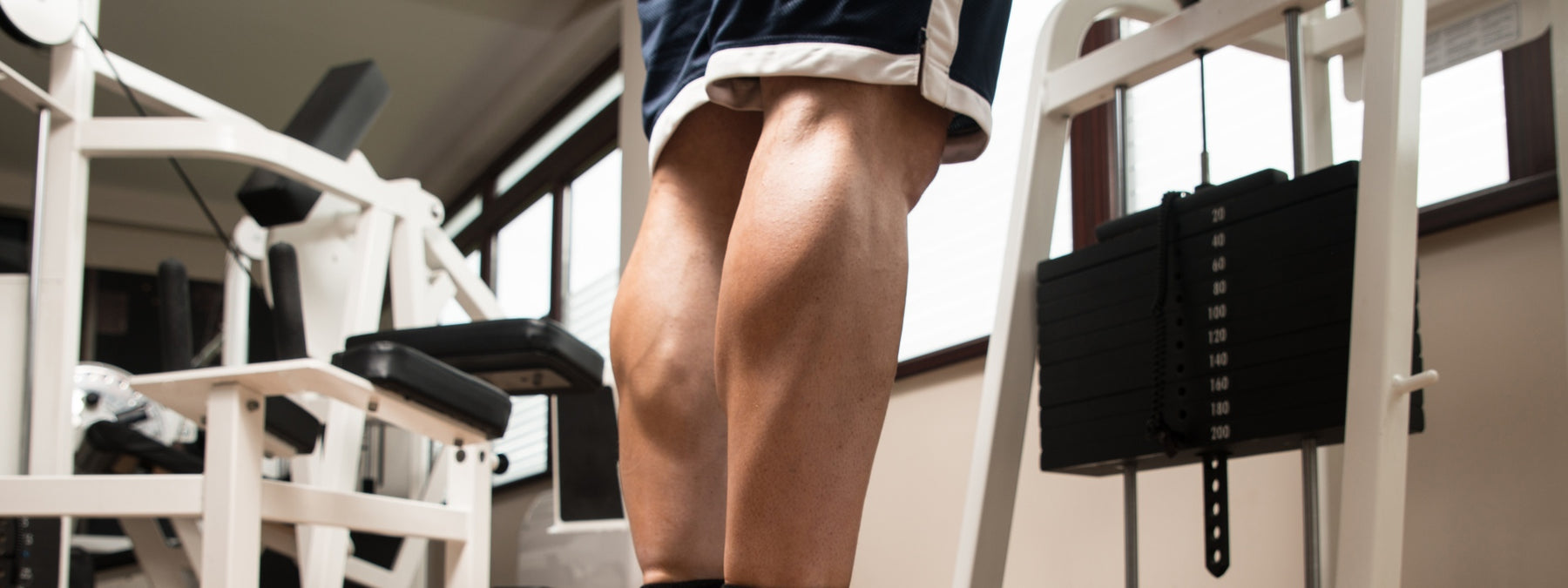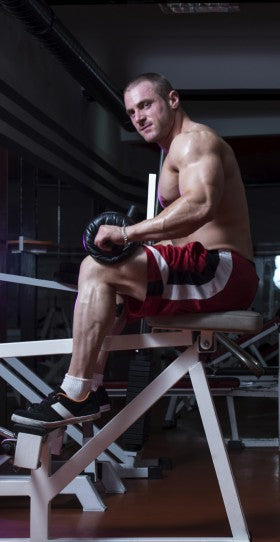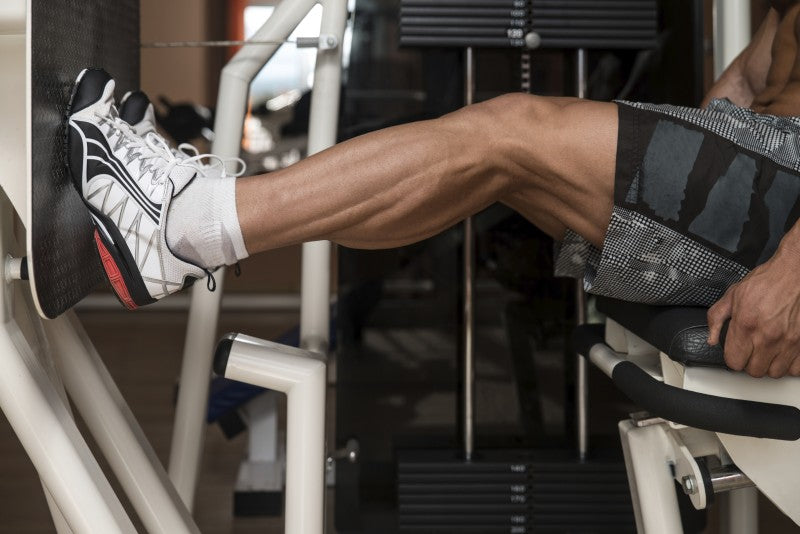
Build Bigger Calves With This Systematic, Can't Fail Workout
Calf training is hard. Really hard.
High rep, low rep, heavy weights, volume, range of motion, tempo, frequency! You've tried it all, but are your calves growing?
There are many myths and legends when it comes to the ?secret? to building bigger calves. First off, some facts.
The calves are made up of two muscles: the gastrocnemius (the big one) and the soleus (the little one). Both originate near the knee and insert near the ankle. They are predominantly fast twitch muscle fibers, used a lot in walking and running where the foot goes from parallel with the floor to a pointed toe.
Related: How to Get Bigger Calves
Your natural calf size and propensity for growth is to a large extent determined by the ?insertion point? of the muscle. If the insertion point is low towards the ankle, the calf muscle occupies a larger space that extends up to the knee. So any development will be more pronounced, especially compared to an individual with a high insertion point and only a few inches of meaty calf.
Look for example at the calves of Tom Platz. They feature a low insertion point. This creates a large, sweeping muscle belly that extends up to the knee.
 Wherever your insertion point you can still work with what you have and grow an impressive set of cows. If we are talking about the Grecian ?aesthetic ideals,? your calves should measure the same as your upper arms at their widest point. Check now and chances are you are a little off that number.
Wherever your insertion point you can still work with what you have and grow an impressive set of cows. If we are talking about the Grecian ?aesthetic ideals,? your calves should measure the same as your upper arms at their widest point. Check now and chances are you are a little off that number.
So how do we ensure proper growth stimulation that will guarantee results over a sustained period of time? The answer lies in a structure I have developed that attacks a few different mechanisms and types of training to systematically annihilate the calves and stimulate them to grow.
Everyone responds to each training stimuli differently. The varied nature of this routine means you will most likely respond well to at least one of the protocols and start making some gains in the lower leg department.
So without further ado, here is ?MOO.? The systematic program to bigger calves.
This should slot into your full routine easily. I recommend 2 workouts a week and it can be done after you train any other muscle group. I currently do it on quad day and on my ?accessory? day when I hit hamstrings and forearms along with calves.
Ensure there is at least 48 hours of rest for the calves before you train them again.
During each workout make sure one of the exercises is seated (with bent knee for soleus focus) and one is standing (with legs straight and quads contracted for gastro focus). You can use a standing calf machine, leg press, smith machine, donkey calf machine or whatever else your gym has.
Perform 20 reps followed by 20 seconds rest. Then immediately hit the same weight for 30 reps and then rest 30 seconds, before a final effort of 40 reps. If you need to pause or lower the weight at any point in the set, do so. Just make sure to get the prescribed number of reps and come back next workout and try again.
When you get the whole set without any pauses or rests move up to the next increment. This next stage you will start with 30 reps and 30 seconds rest, 40 and 40 seconds and then 50 for the last effort. Then once you manage 40/50/60 it is time to up the weight and go back to 20/30/40.
This brutal pump is our benchmark for your calf strength and endurance and you should religiously track how you do each workout. This applies to the whole routine.

Rest one minute maximum. After you have been performing this program for a few weeks, you can add sets to increase volume up to 3 sets per toe orientation (so build up to 9 total).
After each set, knock out 15-20 reps of tibialis raises. Stand up straight and drive your heels into the floor, then raise your toes up while pushing down through the heel.
Start with no weight, then add 5 plates on your toes and see how you go. don't sacrifice range of motion to add weight. It's a tiny enough range as it is!
This exercise hits the front of the lower leg. Supersetting a muscle with its antagonist forces more blood into the limb and is beneficial for both muscles.
Antagonistic training is often used for biceps and triceps, quads and hams, brachialis and brachioradiais... but rarely for calves and tibialis! I don't think I?ve ever seen anyone doing the tibialis raise in a gym. Granted it looks like the most inconsequential exercise ever - but this superset will become a valuable tool in your arsenal and help to carve out some crazy definition over time.
 Switch between workout A and workout B each week.
Switch between workout A and workout B each week.
Overloading the stretched portion of the range (with the heel below the toes) is an unusual stimulus that can illicit major new growth. When you stretch a muscle, particularly with weight, even if it feels relaxed it is still firing. You are performing micro contractions to hold that stretch and are not allowing the muscle to lengthen too far and damage the tissue or tendon.
There are entities called ?golgi tendon organs? which work to prevent this. They sense changes in muscle tension and reflexively contract the muscle to prevent excessive lengthening and injury. Both of these protocols are excruciatingly painful - but they work. If you feel like you can do more after this, you didn't go hard enough.
Choose a seated or standing exercise, whichever variation you didn't perform during protocol 2. Then hit workout A or B, alternating each week.
Have a stopwatch handy and time your stretches. You should feel a deep stretch along the back of the leg, but don't let the foot buckle and overly stress the achillies tendon. Just relax and hold the weight at the bottom of the calves natural range of motion and let the weight do the work.
For stretch overload B, use a weight you can get around 8 reps with. When you fail, take 15 deep breaths then go again. Finish the set when you reach 15 reps or 3 rest pauses: whichever comes first.
A note on calf contraction. During each of these movements make sure to keep the joint moving in a straight line and think about transferring weight into the floor through the ball of your big toe. This will allow for maximal contraction of the calf muscles.
Use a deliberate squeeze at the top of each rep and control the negative so you don't bounce. Bouncing will allow the use of more weight but you'll get less muscle activation and a greater chance of injury on the Achilles tendon.
A lot of people sort of buckle the knees in and raise the heel up and out to use more weight. This results in a poor contraction and sub-optimal gains! For standing or straight leg movements, think about forcibly contracting the quads to keep the leg straight and the tension on the calves.
It goes without saying that in order to truly grow the calves will need the right nutrition, just like any other muscle. This is about the stimulation of the muscle, adding size comes from your caloric surplus. Happy raising!
Author note: Further information on weighted stretching and hypertrophy can be found here. Interestingly, muscle hyperplasia (the growth of new muscle fibers) has never been proven in humans - only hypertrophy (the growth of existing fibers). It has been seen in birds as in this study, and some mammals.
In my opinion, muscle is muscle and I believe humans must be capable of hyperplasia too. According to the literature, stretching in this way is a great way to stimulate hyperplasia so I use it for almost every body part.
High rep, low rep, heavy weights, volume, range of motion, tempo, frequency! You've tried it all, but are your calves growing?
There are many myths and legends when it comes to the ?secret? to building bigger calves. First off, some facts.
The calves are made up of two muscles: the gastrocnemius (the big one) and the soleus (the little one). Both originate near the knee and insert near the ankle. They are predominantly fast twitch muscle fibers, used a lot in walking and running where the foot goes from parallel with the floor to a pointed toe.
Related: How to Get Bigger Calves
Your natural calf size and propensity for growth is to a large extent determined by the ?insertion point? of the muscle. If the insertion point is low towards the ankle, the calf muscle occupies a larger space that extends up to the knee. So any development will be more pronounced, especially compared to an individual with a high insertion point and only a few inches of meaty calf.
Look for example at the calves of Tom Platz. They feature a low insertion point. This creates a large, sweeping muscle belly that extends up to the knee.
Building Bigger Calves Regardless of Genetics
 Wherever your insertion point you can still work with what you have and grow an impressive set of cows. If we are talking about the Grecian ?aesthetic ideals,? your calves should measure the same as your upper arms at their widest point. Check now and chances are you are a little off that number.
Wherever your insertion point you can still work with what you have and grow an impressive set of cows. If we are talking about the Grecian ?aesthetic ideals,? your calves should measure the same as your upper arms at their widest point. Check now and chances are you are a little off that number.So how do we ensure proper growth stimulation that will guarantee results over a sustained period of time? The answer lies in a structure I have developed that attacks a few different mechanisms and types of training to systematically annihilate the calves and stimulate them to grow.
Everyone responds to each training stimuli differently. The varied nature of this routine means you will most likely respond well to at least one of the protocols and start making some gains in the lower leg department.
So without further ado, here is ?MOO.? The systematic program to bigger calves.
This should slot into your full routine easily. I recommend 2 workouts a week and it can be done after you train any other muscle group. I currently do it on quad day and on my ?accessory? day when I hit hamstrings and forearms along with calves.
Ensure there is at least 48 hours of rest for the calves before you train them again.
The MOO Calves Workout
Each workout is comprised of a movement from each of the following:- Protocol 1 - ?Work-to-Rest? Protocol
- Protocol 2 - Straight Sets superset with Tibialis Raise
- Protocol 3 - Stretch Overload A or B
During each workout make sure one of the exercises is seated (with bent knee for soleus focus) and one is standing (with legs straight and quads contracted for gastro focus). You can use a standing calf machine, leg press, smith machine, donkey calf machine or whatever else your gym has.
Calf Protocol 1: ?Work-to-Rest? Protocol
20/30/40 ? 30/40/50 ? 40/50/60
We start each workout with an excruciating pump to drive as much blood into the calves as possible. Start with a relatively light weight and build up from workout to workout.Perform 20 reps followed by 20 seconds rest. Then immediately hit the same weight for 30 reps and then rest 30 seconds, before a final effort of 40 reps. If you need to pause or lower the weight at any point in the set, do so. Just make sure to get the prescribed number of reps and come back next workout and try again.
When you get the whole set without any pauses or rests move up to the next increment. This next stage you will start with 30 reps and 30 seconds rest, 40 and 40 seconds and then 50 for the last effort. Then once you manage 40/50/60 it is time to up the weight and go back to 20/30/40.
This brutal pump is our benchmark for your calf strength and endurance and you should religiously track how you do each workout. This applies to the whole routine.

Your natural calf size and propensity for growth is to a large extent determined by the ?insertion point? of the muscle.
Protocol 2: Straight Sets Superset with Tibialis Raise
Toes facing in x 15, toes straight x 15, toes facing out x 15 superset with...
Tibialis raise 15-20
Rest one minute maximum. After you have been performing this program for a few weeks, you can add sets to increase volume up to 3 sets per toe orientation (so build up to 9 total).
After each set, knock out 15-20 reps of tibialis raises. Stand up straight and drive your heels into the floor, then raise your toes up while pushing down through the heel.
Start with no weight, then add 5 plates on your toes and see how you go. don't sacrifice range of motion to add weight. It's a tiny enough range as it is!
This exercise hits the front of the lower leg. Supersetting a muscle with its antagonist forces more blood into the limb and is beneficial for both muscles.
Antagonistic training is often used for biceps and triceps, quads and hams, brachialis and brachioradiais... but rarely for calves and tibialis! I don't think I?ve ever seen anyone doing the tibialis raise in a gym. Granted it looks like the most inconsequential exercise ever - but this superset will become a valuable tool in your arsenal and help to carve out some crazy definition over time.
Protocol 3: Stretch Overload A or B
 Switch between workout A and workout B each week.
Switch between workout A and workout B each week.- Stretch Overload A - Straight set to deep stretch: 2 sets of 10 reps plus 30 second stretch.
- Stretch Overload B - "The Death Set" using a target of 15 reps. Use tempo of power up, 2 second squeeze, 5 seconds down, 15 second stretch. Maximum of 3 rest-pauses.
Overloading the stretched portion of the range (with the heel below the toes) is an unusual stimulus that can illicit major new growth. When you stretch a muscle, particularly with weight, even if it feels relaxed it is still firing. You are performing micro contractions to hold that stretch and are not allowing the muscle to lengthen too far and damage the tissue or tendon.
There are entities called ?golgi tendon organs? which work to prevent this. They sense changes in muscle tension and reflexively contract the muscle to prevent excessive lengthening and injury. Both of these protocols are excruciatingly painful - but they work. If you feel like you can do more after this, you didn't go hard enough.
Choose a seated or standing exercise, whichever variation you didn't perform during protocol 2. Then hit workout A or B, alternating each week.
Have a stopwatch handy and time your stretches. You should feel a deep stretch along the back of the leg, but don't let the foot buckle and overly stress the achillies tendon. Just relax and hold the weight at the bottom of the calves natural range of motion and let the weight do the work.
For stretch overload B, use a weight you can get around 8 reps with. When you fail, take 15 deep breaths then go again. Finish the set when you reach 15 reps or 3 rest pauses: whichever comes first.
A note on calf contraction. During each of these movements make sure to keep the joint moving in a straight line and think about transferring weight into the floor through the ball of your big toe. This will allow for maximal contraction of the calf muscles.
Use a deliberate squeeze at the top of each rep and control the negative so you don't bounce. Bouncing will allow the use of more weight but you'll get less muscle activation and a greater chance of injury on the Achilles tendon.
A lot of people sort of buckle the knees in and raise the heel up and out to use more weight. This results in a poor contraction and sub-optimal gains! For standing or straight leg movements, think about forcibly contracting the quads to keep the leg straight and the tension on the calves.
It goes without saying that in order to truly grow the calves will need the right nutrition, just like any other muscle. This is about the stimulation of the muscle, adding size comes from your caloric surplus. Happy raising!
Author note: Further information on weighted stretching and hypertrophy can be found here. Interestingly, muscle hyperplasia (the growth of new muscle fibers) has never been proven in humans - only hypertrophy (the growth of existing fibers). It has been seen in birds as in this study, and some mammals.
In my opinion, muscle is muscle and I believe humans must be capable of hyperplasia too. According to the literature, stretching in this way is a great way to stimulate hyperplasia so I use it for almost every body part.

Leave a comment